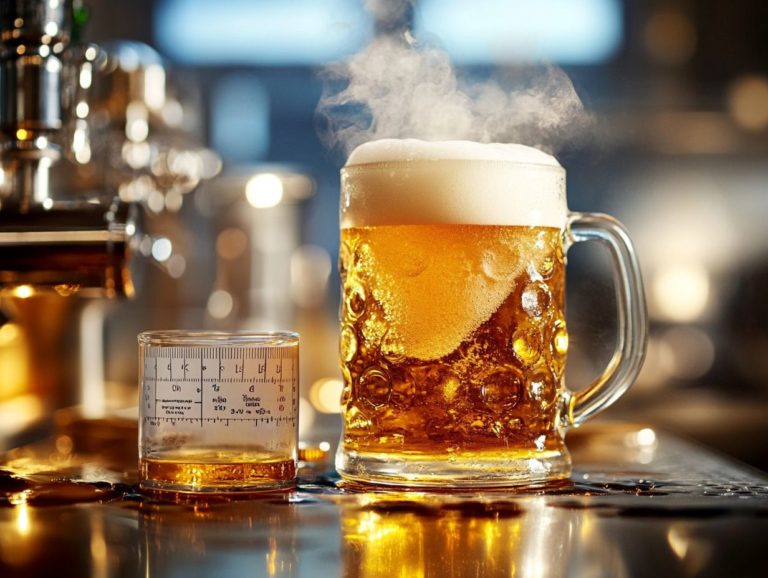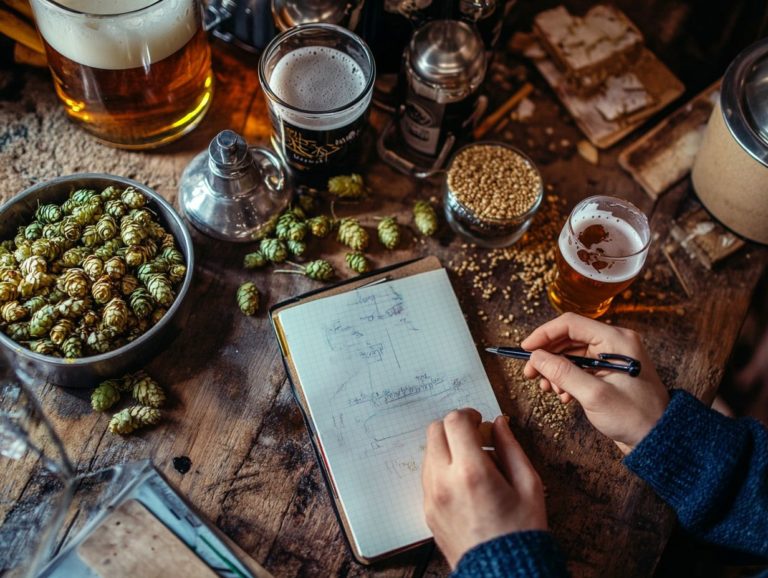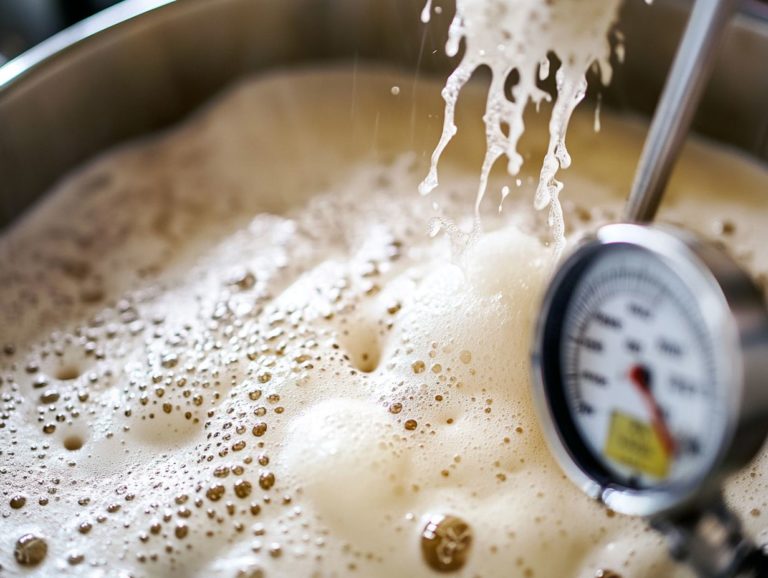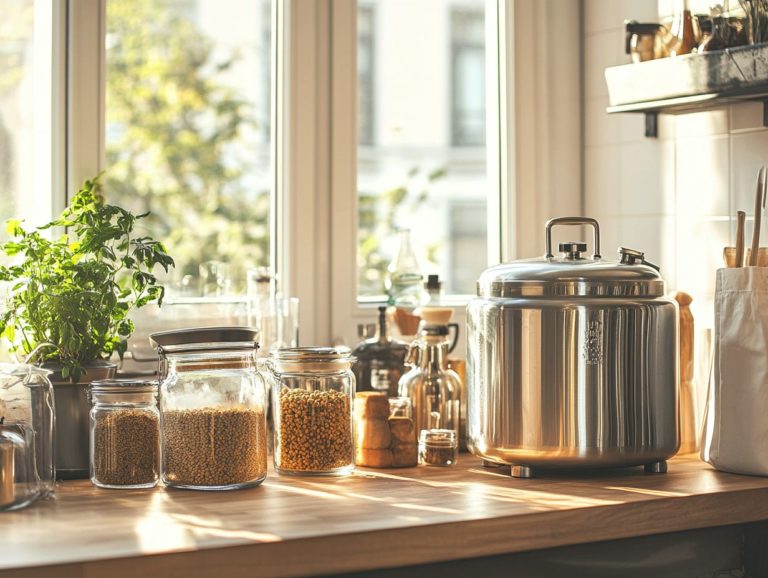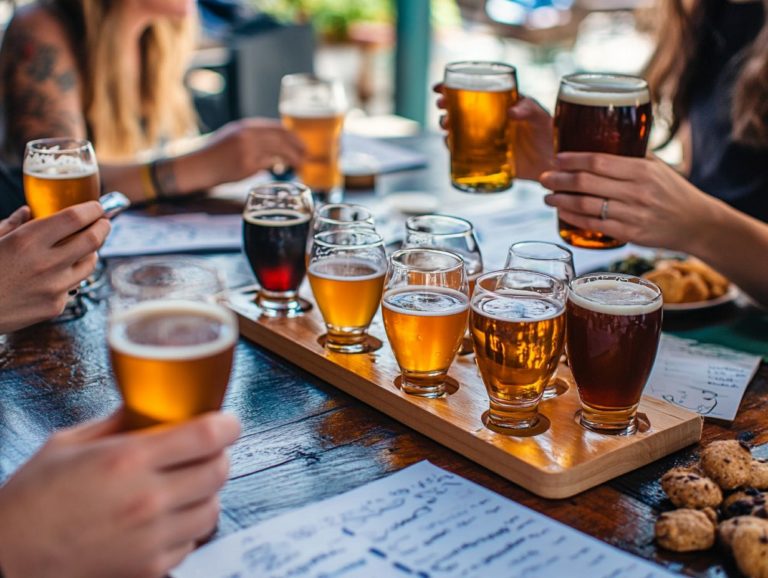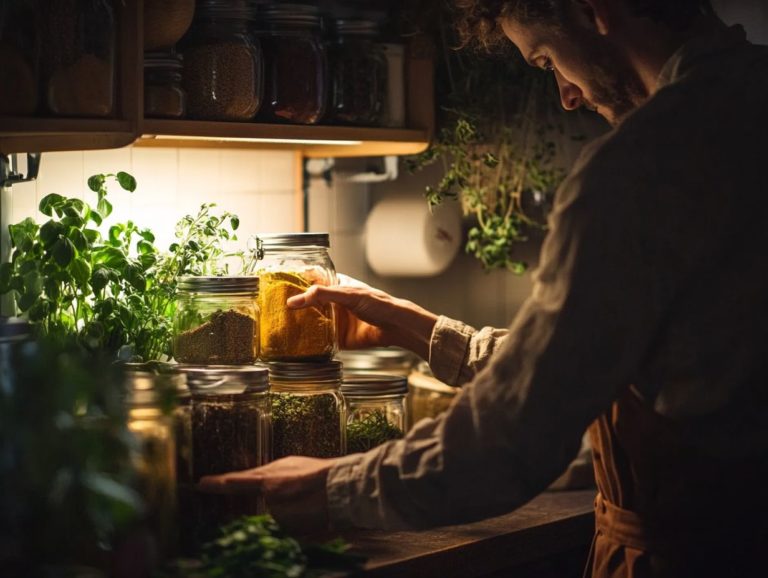How to Detect and Fix Off-Colors in Beer
Contents
- Understanding Off-Colours in Beer
- Key Takeaways:
- What Causes Off-Colors in Beer?
- What Are the Common Off-Colors in Beer?
- How to Detect Off-Colors in Beer?
- How to Fix Off-Colors in Beer?
- How to Use Additives to Fix Off-Colors in Beer?
- How to Blend Different Batches of Beer to Correct Color?
- Tips for Preventing Off-Colors in Beer
- How to Properly Store and Handle Ingredients to Maintain Color?
- How to Control Mash and Boil pH to Prevent Color Changes?
- How to Monitor and Adjust Fermentation to Avoid Off-Colors?
Understanding Off-Colours in Beer
Beer brewing is a cherished activity that countless people enjoy, yet off-colors can present a frustrating challenge for both brewers and enthusiasts.
Grasping the factors that lead to these color variations ranging from the effects of yeast and hops to the typical off-colors you might encounter is crucial for crafting the perfect brew. Understanding the influence of malt extract and brewing water further deepens this knowledge.
Get ready to master your brewing skills with this exciting guide that will help you tackle off-colors head-on! This guide will empower you to identify and rectify off-colors, providing you with practical brewing tips and techniques to maintain the visual allure of your beer.
Whether you re a seasoned brewer or simply a curious consumer, you ll discover valuable insights that can elevate your brewing experience to new heights. From yeast fermentation to understanding the brewing process, this guide covers it all.
Key Takeaways:
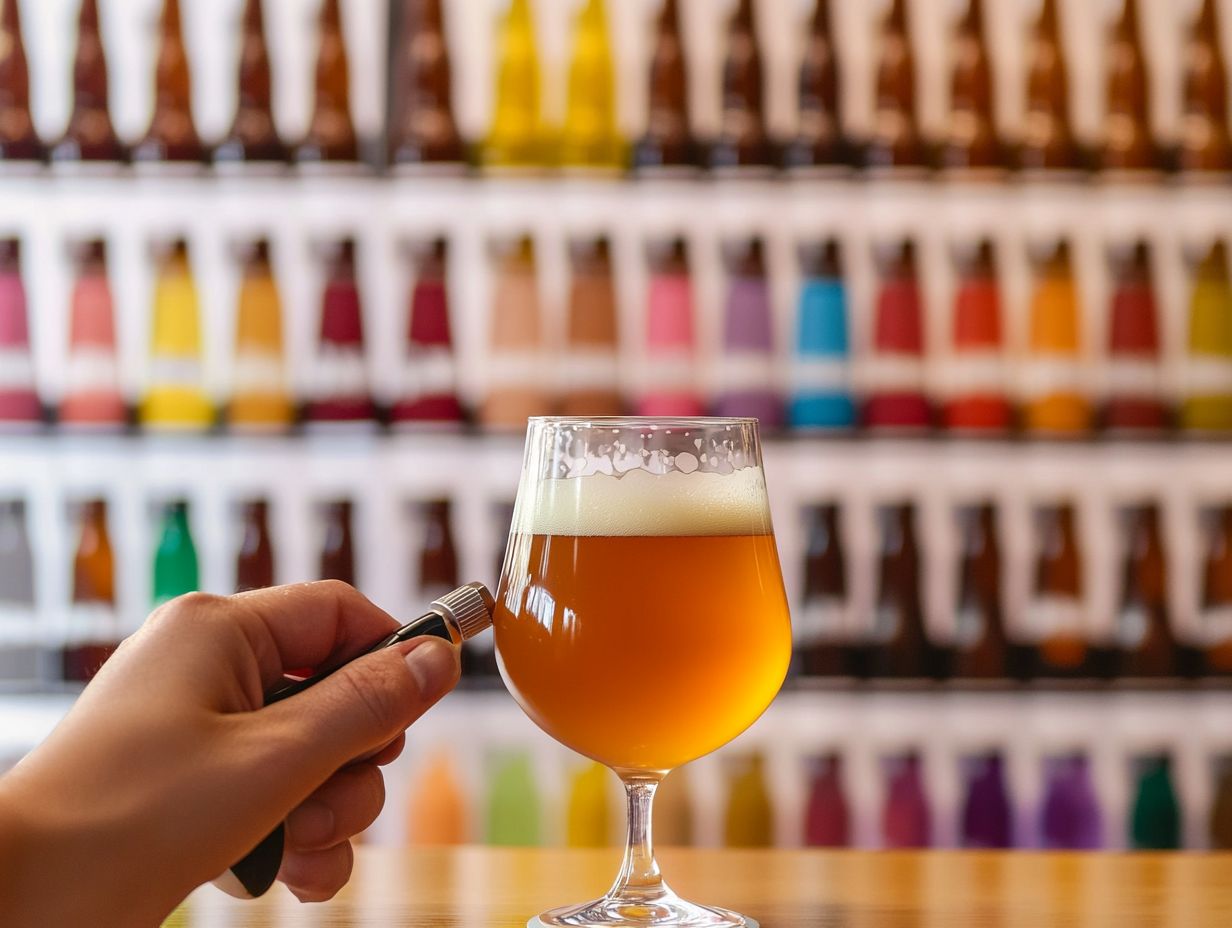
- Off-colors in beer can be caused by various factors, such as yeast and hops.
- To detect off-colors, inspect the wort color and use a colorimeter to measure. Different beer styles have acceptable color ranges.
- To fix off-colors, adjust the brewing process, use additives, or blend batches of beer. Proper storage and handling of brewing ingredients, controlling pH, and monitoring fermentation can prevent off-colors.
What Causes Off-Colors in Beer?
Off-colors in beer can stem from a variety of factors throughout the brewing process. The selection of brewing ingredients, such as malt extract and roasted grains, plays a crucial role in shaping the beer s hue.
Chemical reactions, particularly a chemical reaction that occurs when heating which affects color, during heating, contribute to the final color. The quality of your brewing water is essential, as it can significantly influence the beer’s color profile.
Improper pH levels during mashing and boiling can introduce unwanted color variations, leading to beers that fall short of the expected standards for their respective styles whether you re aiming for a crisp pilsner or a rich porter stout. Tackling pH problems early in the brewing process is crucial for achieving your desired beer style.
How Do Yeast and Hops Affect Beer Color?
Yeast and hops are pivotal players in the world of beer, significantly influencing its color. The fermentation process of yeast affects the clarity and brightness of the final product.
The type, timing, and quantity of hops you choose to use contribute to the nuanced flavor profiles and delicate hues found across various beer styles. Proper hop utilization and considering late additions can further enhance these outcomes.
Each yeast strain you select brings its own unique characteristics that can either enhance or soften the color variations in your brew. For example, some strains create a desirable hazy look, perfect for styles like New England IPAs, while others yield the crystal-clear appearance typical of lagers.
Yeast reuse can also impact the fermentation process and contribute to beer clarity. Regarding hop additions, the timing is crucial especially late hopping. This technique can elevate not just the aroma but also the visual allure of the beer.
Late hop additions focus less on bitterness and more on delivering vibrant flavors and fragrances, often resulting in lighter hues that tantalize the palate and create a complex depth of taste. Effective hop utilization and considering late additions are key strategies in advanced brewing techniques.
Now that you ve learned about off-colors and their causes, dive into your brewing process today and transform your beer into a visual masterpiece!
What Are the Common Off-Colors in Beer?
When brewing, you may notice some common off-colors in your beer. For example, you might end up with a surprisingly dark brew when you intended to create a light pilsner, or a pale ale that leans too far into copper territory. These unexpected shades often stem from brewing errors, ingredient choices, or miscalculations in gravity readings throughout the brewing process. Utilizing Standard Reference Method (SRM) charts can help mitigate these brewing challenges.
Such color discrepancies can result from various brewing missteps. Perhaps you used overly roasted malts or allowed the wort to boil for too long, inadvertently darkening it more than you planned. If the water chemistry is not optimized, it can significantly impact the final hue of your beer, leading to those surprising colors. Using roasted barley or cold steeping methods can also influence the color of your brew.
For those passionate about brewing, the SRM chart becomes an invaluable tool for measuring and adjusting color with precision. Understanding common challenges, such as the Maillard reaction a chemical reaction that occurs when proteins and sugars in the wort heat up, leading to browning and flavor development is crucial to brewing success. Engaging in brewing discussions can further enhance your understanding and application of the SRM chart.
How to Detect Off-Colors in Beer?
Detecting off-colors in beer necessitates meticulous observation of both the beer clarity and the wort’s color. To aid in this process, utilizing tools like a colorimeter a device that measures color intensity in liquids can prove invaluable, offering precise measurements that empower brewers to identify any deviations from the standard color profiles established within brewing conventions and discussions. This is particularly important for extract brewers who rely on precise color metrics.
What to Look for When Inspecting Beer Color?
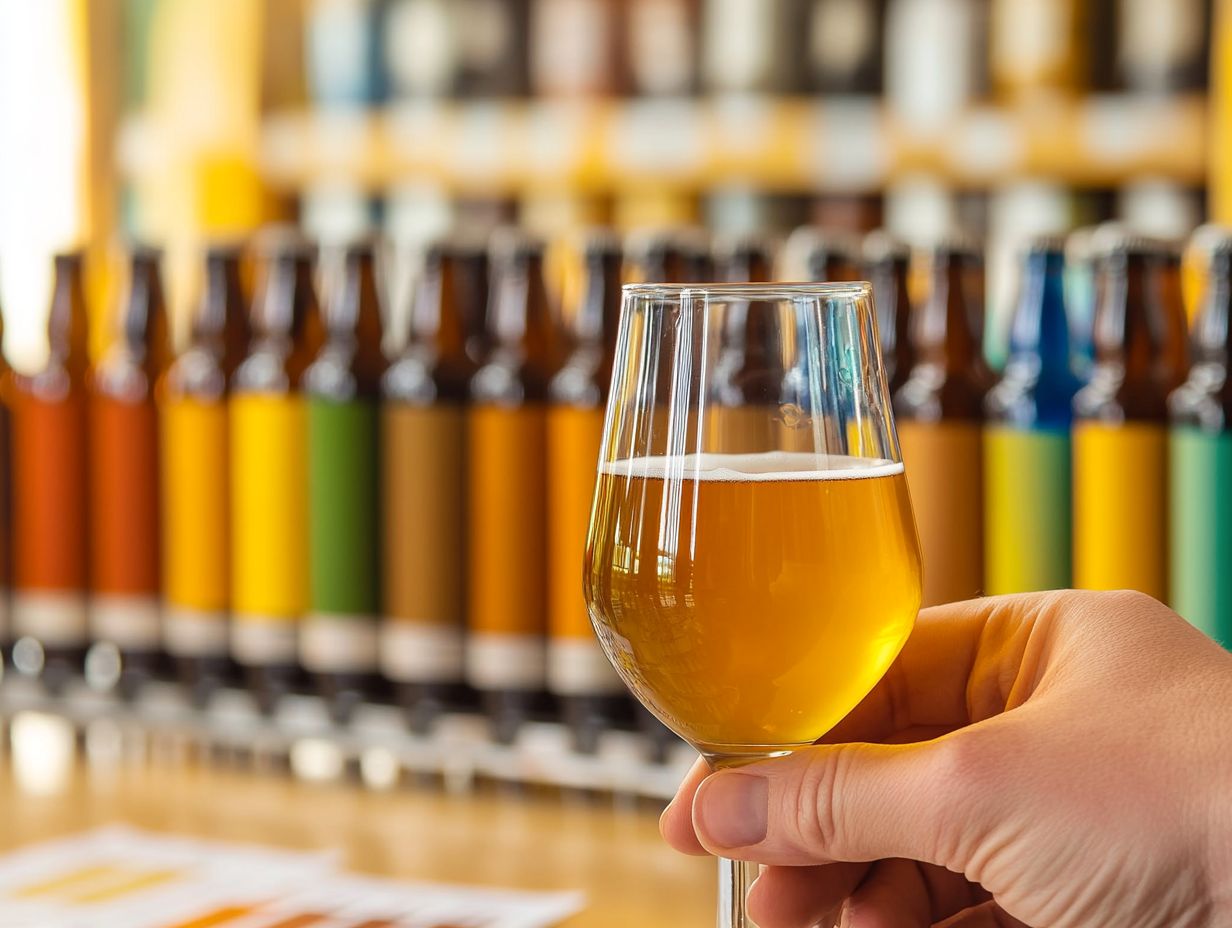
When you inspect beer color, it s crucial to focus on clarity, consistency, and any unexpected hues that might stray from the anticipated color spectrum for the chosen beer style. Don t forget to consider factors such as the quality of your brewing water, the sugar content in the wort, and any potential pH issues that could affect the final appearance.
These elements are vital for ensuring that your beer meets visual expectations and embodies the unique characteristics of each style. For instance, clarity can signal effective filtration practices and the absence of unwanted particles. Color consistency across batches is a testament to quality control throughout your brewing process. Any deviation in hue could hint at problems like over-roasted malts or incomplete fermentation. Adjusting the fermentation temperature can also play a significant role in achieving desired clarity and color.
By monitoring the mineral content of your brewing water and adjusting the mash pH, you can refine color outcomes further, achieving a balanced visual appeal that beautifully complements the flavor profile.
By thoughtfully addressing these variables, you can create a beer that is not just visually captivating but also a true reflection of your craftsmanship.
Now that you understand how to detect and fix off-colors in beer, you can also learn how to troubleshoot off-flavors in beer. Grab your brewing tools and start crafting your best batch yet!
How to Use a Colorimeter to Measure Beer Color?
Using a colorimeter to measure beer color is a meticulous yet rewarding process. Begin by taking a carefully prepared sample of beer, making sure to eliminate any bubbles that could interfere with the readings. Once you’re ready, place the sample into the device to obtain readings expressed in SRM (Standard Reference Method) or EBC (European Brewing Convention) values. These measurements are invaluable for assessing wort transfer processes and ensuring color consistency in your brews.
For accurate results, it s essential to start with a pristine sample. Filter the beer through a sterile medium to remove any particulate matter that might skew your readings. Once filtered, fill the cuvette (a small container that holds the beer sample during measurement), being careful to fill it to about three-quarters full to prevent any interference with the light path. Don t forget to wipe away any excess liquid from the exterior, as even the smallest smudge can affect your results.
Next, calibrate the colorimeter according to the manufacturer’s guidelines, using appropriate standards to guarantee precise readings. Understanding these color metrics is crucial for you as a brewer. They not only define the visual allure of your final product but also play a significant role in shaping flavor profiles and quality. These insights will guide you in maintaining product consistency throughout your brewing journey.
What Are the Acceptable Color Ranges for Different Beer Styles?
Understanding the acceptable color ranges for various beer styles is essential for you as a brewer. Each style, from the lightest straw to the deepest dark beer, comes with specific SRM chart guidelines that define its expected appearance and help maintain flavor balance.
These color variations do more than just catch the eye; they also hint at the underlying flavors and aromas that await in the final product. For instance, you ll find that pale ales typically reside within the light to golden range, suggesting the refreshing citrus notes they often carry. In contrast, stouts, with their rich brown to black hues, indicate robust and complex flavors like chocolate and coffee.
By utilizing SRM charts, you can make informed decisions about ingredient selection think malts and adjuncts and fine-tune your brewing processes to achieve the desired results. This ensures that the final beer not only looks enticing but also lives up to the traditional expectations of its style. Additionally, understanding the impact of Belgian candi sugar or considering the use of Campden tablets can further refine your brewing techniques.
How to Fix Off-Colors in Beer?
Addressing off-colors in beer requires a thoughtful approach, involving a series of deliberate adjustments throughout the brewing process. You ll want to employ effective color adjustment techniques and utilize insightful brewing tips to rectify any issues. Engaging with the brewing community and participating in beer festivals can provide additional inspiration and practical solutions.
Reusing yeast can enhance fermentation clarity and improve the overall appearance of your beer.
How to Adjust the Color of Beer During the Brewing Process?
Adjusting the color of your beer during the brewing process can be an exciting challenge! With the right techniques, you can transform your brew into a visual masterpiece. This includes selecting the right malt profile and using roasted grains. Time your ingredient additions carefully to achieve the hue and clarity you desire.
One effective way to enhance color is by incorporating specialty malts, such as crystal or caramel malts. These can impart rich amber or copper tones, depending on the degree to which they are roasted. If you’re aiming for deeper shades, consider the addition of roasted barley or chocolate malt; these are essential for crafting stouts and porters with that luxurious dark brown or black appearance. Additionally, roasted grains can enrich the malt profile, adding complexity to your brew.
Timing is also pivotal in this endeavor. For example, adding darker grains later in the mash process can prevent an unwelcome bitterness while still enhancing the color. Ultimately, by thoughtfully considering ingredient proportions and incorporating adjuncts, along with making strategic modifications to your brewing schedule, such as the late addition of certain grains, you can significantly elevate the visual allure of your final product.
How to Use Additives to Fix Off-Colors in Beer?
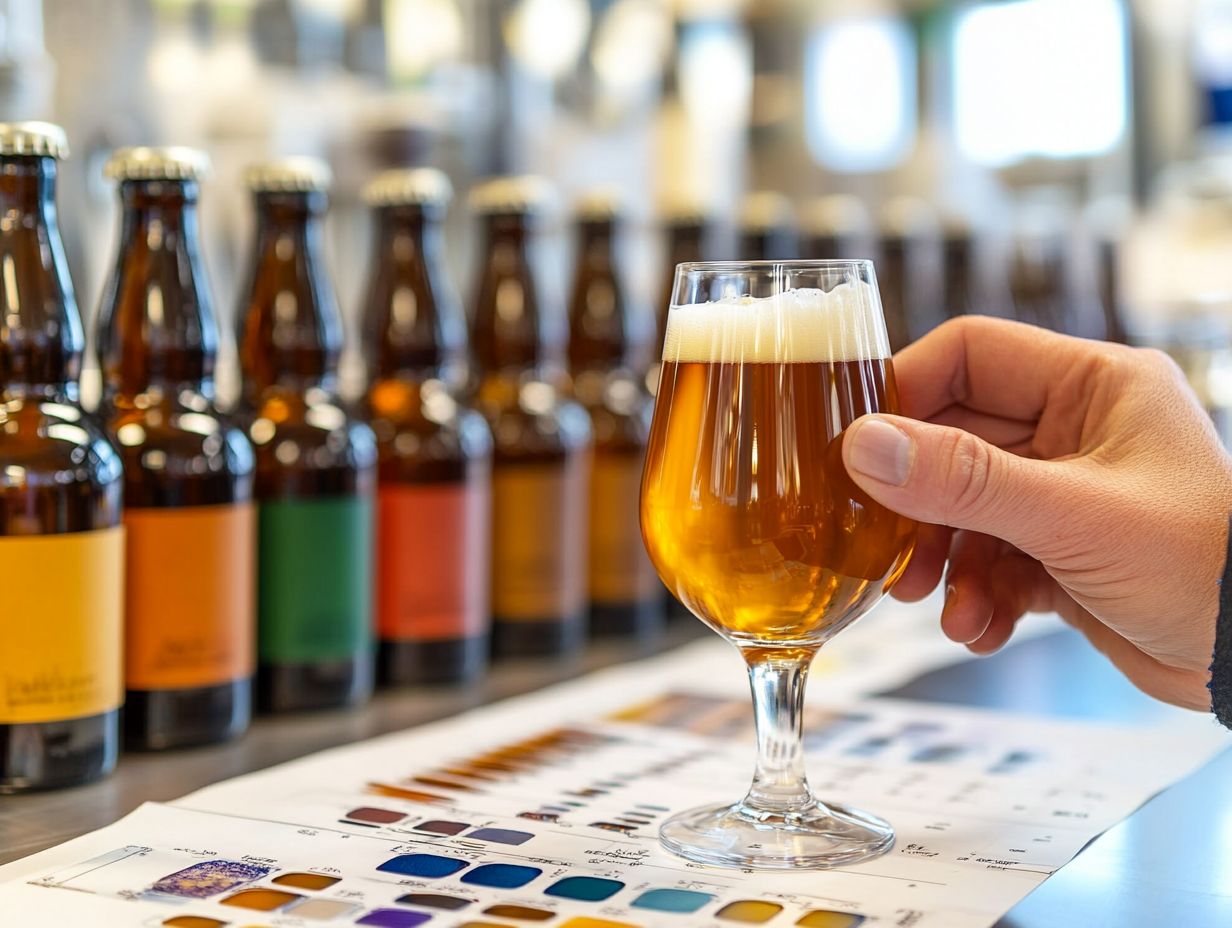
Using additives can correct off-colors in beer. Ingredients like Belgian candi sugar and other color enhancers can help achieve the perfect appearance.
These additives also provide a rich caramel color. They enhance the complexity of flavor, elevating your overall drinking experience. For instance, chocolate malt and crystal malts are often your go-to choices for imparting specific shades and depth to stouts and porters.
Roasted malt can also enhance the color profile of these beer styles. However, you must tread carefully with the quantities, as too much can lead to unwanted sweetness or overpowering flavors.
Properly incorporating these additives at various brewing stages is essential. Knowing the precise impact of each additive on both color and taste can dramatically shape your final product. Therefore, experimentation and experience are critical elements of successful brewing.
For extract brewers, understanding the nuances of each additive’s impact is especially important for achieving the desired color and flavor balance.
How to Blend Different Batches of Beer to Correct Color?
Blending different batches of beer to achieve the perfect color is a sophisticated technique. It allows you to create a harmonious final product, striking a balance between the desired hue and flavor while ensuring brewing efficiency.
To master this art, start by evaluating the flavor profiles of each beer batch. Consider utilizing an SRM chart to help guide your color adjustments.
Pay close attention to their unique characteristics and think about how they might complement each other. Begin by pouring small samples of each beer into separate glasses to assess their aromas and tastes. Take note of any standout attributes that catch your palate’s attention.
Next, evaluate the color of each sample; this step will inform the blending ratios needed to reach that ideal shade. Gradually combine the samples, starting with equal parts, and taste each blend to decide if any adjustments are necessary.
This meticulous process ensures that your final beer not only has the right color but also aligns beautifully with the intended flavor profile. The result will be a well-rounded and enjoyable brew!
Tips for Preventing Off-Colors in Beer
To effectively prevent off-colors in your beer, embrace a series of steps to prevent color issues. This includes carefully checking the fermentation temperature, maintaining optimal water chemistry, and ensuring the proper handling and storage of your brewing ingredients.
Each of these elements plays a crucial role in influencing the final color of your brew. They help you achieve the desired outcome with finesse.
How to Properly Store and Handle Ingredients to Maintain Color?
Properly storing and handling your brewing ingredients is essential for preserving the vibrant color of your beer. Pay attention to factors such as the quality of your brewing water. Ensuring that your ingredients are free from contamination can help you avoid pesky color changes that can mar your final product.
Incorporating cold steeping techniques can also preserve the vibrant color of your beer.
To create the optimal storage conditions, it s vital to regulate temperatures for both malt and hops. Excessive heat can quickly degrade their quality, leading to off-colors that nobody wants in their brew.
By maintaining a cool, dark, and dry environment, you can significantly enhance the shelf life and integrity of your ingredients. Proper storage is crucial for both malt extract and whole grains to prevent degradation.
Using airtight containers is a savvy move, as they shield your ingredients from moisture and pests that can introduce undesirable flavors and hues.
Make it a habit to regularly check for signs of contamination, like unusual odors or discoloration. This proactive approach can prevent further complications in your brewing process. It ensures that the appearance and taste of your final beer remain exactly as you envisioned.
Don’t wait until it’s too late to safeguard your ingredients act now for the best results!
How to Control Mash and Boil pH to Prevent Color Changes?
Controlling the mash and boil pH is essential to prevent any unwelcome color changes in your beer. Inappropriate pH levels can lead to undesirable hues during wort transfer and fermentation, ultimately impacting both the appearance and taste of your brew. Proper pH management plays a crucial role in optimizing hop utilization and achieving the intended wort color.
To achieve optimal pH levels, regularly test and adjust the acidity throughout the brewing process. Utilizing pH strips or meters will help you monitor these levels. An ideal mash pH hovers around 5.2 to 5.6 for pale ales, while stouts thrive in slightly different pH ranges. This meticulous control prevents color shifts and maintains the desired malt profile.
The influence of pH on color is quite significant. For example, higher pH levels can yield a lighter color and diminish malt flavor, potentially compromising your final product. By managing pH, you enhance flavor profiles and ensure that the visual characteristics of your beer align with your expectations, ultimately elevating overall consumer satisfaction.
How to Monitor and Adjust Fermentation to Avoid Off-Colors?
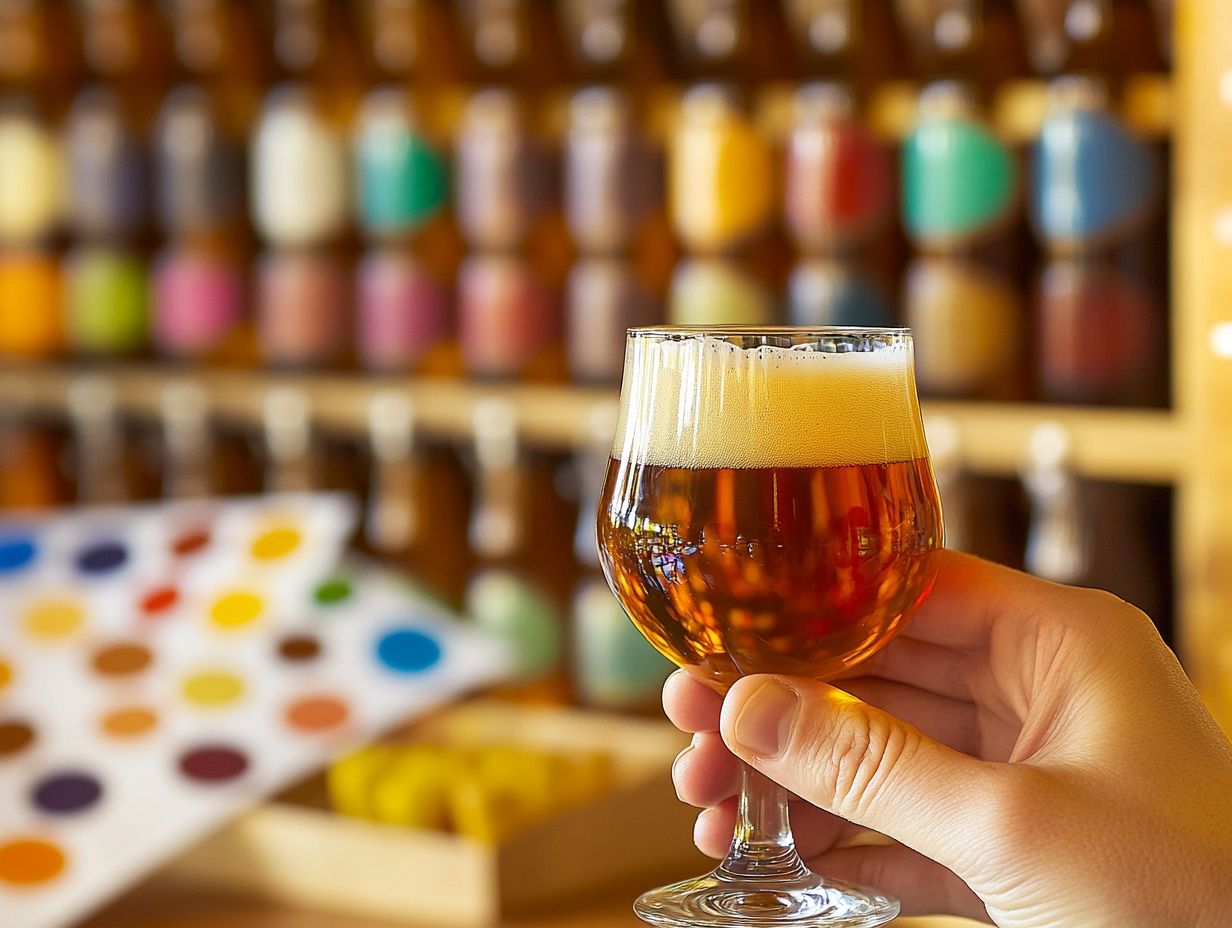
Keep a close eye on your fermentation practices to achieve the perfect color in your beer. The fermentation process significantly determines the final color, and using a yeast starter can greatly enhance yeast health and activity, resulting in clearer beer.
Establish a consistent fermentation temperature; any fluctuations can introduce unwanted compounds that might alter both the flavor and appearance of your brew. Aim for a specific temperature range that aligns with the yeast strain you’re using. Be prepared to make timely adjustments to maintain that all-important stability. Regular gravity readings are your best friends they confirm that fermentation is on track and help you predict the final color contributions. This proactive approach is vital in maintaining a consistent brewing cycle.
By implementing best practices, such as monitoring timing and temperature, you can create a uniform color profile that enhances the overall quality and presentation of your beer. This attention to detail is often discussed at brewing conventions and forums, where sharing experiences can lead to new insights and improvements.
Frequently Asked Questions
What are off-colors in beer?
Off-colors in beer refer to any abnormal hue or shade in the beer’s appearance, such as a green or brown tint. These off-colors can result from various factors, including improper brewing techniques or contamination.
How can I detect off-colors in beer?
The best way to detect off-colors in beer is by visually examining its appearance. If the beer appears cloudy, has an unusual tint, or looks murky, it may be a sign of off-colors. Off-colors can also affect the taste and aroma of the beer.
What are the common causes of off-colors in beer?
Off-colors in beer can stem from a variety of factors, such as using contaminated water, old or expired ingredients, or improper storage and handling. Additionally, certain brewing techniques or equipment can contribute to off-colors.
How can I fix off-colors in beer?
The best way to fix off-colors in beer is to identify the specific cause and address it accordingly. For example, if contamination causes the off-colors, thoroughly cleaning and sanitizing the equipment while using fresh ingredients can help resolve the issue. Adjusting your brewing process may also improve the beer’s color. Employing a yeast starter can enhance yeast health and mitigate off-colors.
Can off-colors in beer be harmful?
In most cases, off-colors in beer are not harmful and are primarily an aesthetic issue. However, if the off-colors arise from contamination with harmful bacteria or molds, consuming the beer may pose health risks. It is crucial to identify and address the cause of off-colors to ensure the safety of the beer.
Ready to experiment with your brewing techniques? Share your experiences and let’s create the perfect brew together!
How Can I Prevent Off-Colors in Beer?
The best way to prevent off-colors in beer is to follow proper brewing techniques and use fresh, high-quality ingredients. Regularly cleaning and sanitizing your equipment is crucial.
Store your beer properly and keep a close eye on the fermentation process. Join the brewing community to discover valuable tips and strategies to enhance your beer quality!

